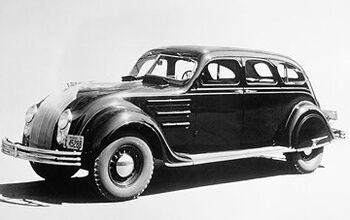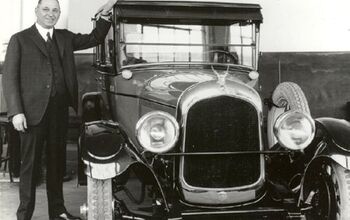Chrysler Suicide Watch 32: Slumlords
It’s getting close to the first anniversary of Chrysler going to the dog. While there’ve been job cuts and “market adjustments,” the shoes are still hanging. Chrysler is still a long way from being profitable. But it appears to be an equally long way from breakup. What exactly is planned? The truth may be that Cerberus isn't “planning” so much as “waiting.”
For Cerberus, buying Chrysler was a gamble. As you’d expect from New York money men, they did several things to “stack the deck.” First, they got the company for a song (under seven and a half billion) with some working capital included. More importantly, they took the automaker private. With no shareholders to whine about dividends, no “captain Kirks” to try to swing a takeover, Cerberus can afford to take the long view. And the long view says… go public. Or strip and flip. Either way, now’s not the time.
Cerberus’ holding pattern has less to do with ChryCo’s declining fortunes than OTHER carmakers’ declining fortunes. In other words, you can’t flip a company without a flipee. The current U.S. automotive market leaves very few players flush with cash, looking for an American dance partner. And those that are, aren’t. Splitting-up Chrysler’s assets is the only realistic alternative, and that idea poses involves many of the same issues.
At the moment, Jeep is only spinnable hunk of Chrysler. (No surprise there; Jeep’s had more “partners” than the widow next door.) Jeep is the only part of Cerberus’ entire car making operations with a positive cash-flow. While the profits aren’t enormous, the brand’s “trail-ratings” carry enough cachet to allow big mark-ups on simple vehicles.
There are several problems with Cerberus selling Jeep sooner rather than later. First, while Jeep’s hard-core fan base is less (more?) affected by fashion than most, SUVs are not the flavor of the month. The new U.S. federal corporate average fuel economy (CAFE) regulations are in flux, awaiting clarification and California-compliance (or not). In any case, whatever Cerberus could get for Jeep now pales is comparison to what Jeep would be worth in a hot, relatively settled market.
Next and again, who’d buy Jeep? With credit in short supply, a US-market outsider would have trouble stumping-up the dough to snag it. And those foreign firms that could afford Jeep (BMW, Toyota, Honda, etc.) either already have off-road products or don’t want them. VW is busy. Daimler is sitting in the corner, grinning.
Renault/Nissan is the only like foreign suitor— only they aren’t. Carlos Ghosn may make noises about mergers, but there ARE limits. And lest we forget, NONE of the imports are brave/stupid enough to buy a unionized company, bringing the (free!) Trojan horse through the gates. Domestically, Ford just sold Land Rover. And although GM has decades of experience cannibalizing itself, even RenCen knows it doesn’t need Hummer AND Jeep.
Besides, what would Cerberus do with the rest of the company after they stripped-out the only part anyone wants? China is often named as a potential buyer, but even for pennies on the dollar for U.S. production capacity and access to thousands of dealers, they’d see Chrysler as the financial sinkhole that it is.
No matter how much— or more likely little— Cerberus made from a larger Chrysler breakup, it could be the volte face that launches a thousand lawsuits. Shuttering Oldsmobile cost GM billions; the General’s terminal brand wasn’t a fraction the size of Chrysler, Dodge or Jeep (never mind the three brands combined). Filing for bankruptcy and THEN selling off the bits would mitigate Cerberus’ legal risk, but it’s hardly a profitable exit strategy. If nothing else, Chapter 11 would decimate the brands’ street value.
As I stated at the beginning, any fool knows that Chrysler is a long, long way from profitability. But who said anything about profitability (other than me)? Cerberus doesn’t have to “build equity;” they don’t have to justify their decisions to institutional shareholders. Think of Chrysler as a slum landlord who bought a building on the cheap awaiting a buyout offer and you begin to get the picture.
Watch as Chrysler reins-in R&D while “consolidating” dealers (i.e. watching them die). This viewpoint explains “quicker than quick” Chrysler’s strange reluctance to cut vehicle lines that everybody (but their few remaining buyers) know are dead in the water. The superabundance of product forces dealers to go tits up, and leave their proverbial apartments.
Remember: Cerberus is in this to make money, not to “save Chrysler.” They need to get their $8b back, plus a little extra (Daimler holds 19.9 percent). To do that, all they have to do is run the business into the ground. When the time comes to “sell Jeep, liquidate the rest,” Chrysler’s corporate coffers will be conveniently bare (or pretty close). The lawyers can fight over the bones. And the “dog” will have had its day.
More by Andrew Dederer
Latest Car Reviews
Read moreLatest Product Reviews
Read moreRecent Comments
- Kwik_Shift_Pro4X The dominoes start to fall...
- IBx1 Get the standard established, then stop building the chargers while you let others license the design from you to build more stations with your standard disgusting
- IBx1 “Dare to live more”-company that went from making the Countach and Diablo to an Audi crossover with an Audi engine and only pathetic automatic garabge ”live mas”-taco bell
- Pianoboy57 Not buying one of these new when I was a young guy was a big regret. I hated the job I had then so didn't want to commit to payments. I did own a '74 Corona SR later for a short time.
- FreedMike This wasn’t unpredictable. Despite what the eV HaTerZ kLuBB would like you to believe, EV sales are still going up, just not as quickly as they had been, but Tesla’s market share is down dramatically. That’s the result of what I’ve been saying for a long time: that the competition would eventually start catching up, and that’s exactly what’s happening. How did this happen? It boils down to this: we’re not back in 2019 anymore. Back then, if you wanted an EV that wasn’t a dorky looking ecomobile like a Leaf or Bolt, it was pretty much Tesla or bust, and buyers had to deal with all the endemic Tesla issues (build quality problems, bizarre ergonomics, weird styling, and so forth). That’s not the case today – there is a ton of competition, and while these newer models aren’t quite there when it comes to EV tech, they’re getting closer, and most of the Tesla weirdness just doesn’t apply. And then there’s this: stale product is the kiss of death in the car biz, and aside from the vanity project known as Cybertruck, all of Tesla’s stuff is old now. It’s not as “bleeding edge” as it used to be. For a company that made its’ bones on being on the forefront of tech, that’s a big problem.I don’t think Tesla is out of the game – not by a long shot. They’re still the market leader by a very wide margin, and their EV tech is the best in the game. But they need to stop focusing on stuff like the Cybertruck (technically fascinating, but it’s clearly an Elon Musk ego trip), the money/talent suck that is FSD, and the whole robotaxi thing, and put product first. At a minimum, everything they sell needs a very heavy refresh, and the entry level EV is a must.


































Comments
Join the conversation
At the risk of making this a geo-political discussion, I'll hold back on the last few interesting comments although there's a part of me that would love to have talk about em' over lunch. I'll say this about Chrysler. It WILL go bankrupt and it WILL happen within the next two years. After that it's pretty much anyone's guess. As an aside, anyone who spends serious time at the dealer auctions has seen the fantastic degradation of their product. From 2004 onward they have been on such a terrible decline that nothing within the realm of reality could have saved them. I still blame Daimler... chances are they would have been the healthiest one of the 2.8 if the morons at Mercedes didn't drastically cut their R&D budget and neglect to share any of the platforms or parts bin materials that were sorely needed.
Basically Cerebus was paid by MB to take Chrysler off their hands so they would take it through Bankruptcy and kill the Unions. Remember they hired Neutron Bomb (kills people and leave buildings) Nardelli to come in to do what present management could not. Jim Press is to make it appear like they are trying. Nardelli already stated they are going to sell off Real Estate that Chrysler owns. Approximately $1.4 billion worth. Goodbye proving grounds! Remember the Carlsbad design facility was shut down. If Cerebus can't wrestle this beast as its mythical name suggests they will sell it to an Indian company. Tata and Mahindra are very capable of buying it. Tons of companies in India are awash in prive equity. Tata is shopping; they bought a Dutch steel company for 12.2 billion and now land rover and Jaguar for a a mere 2.3 billion, while saying they will invest $1.5-3 billion in capital investments (expanding production for one).